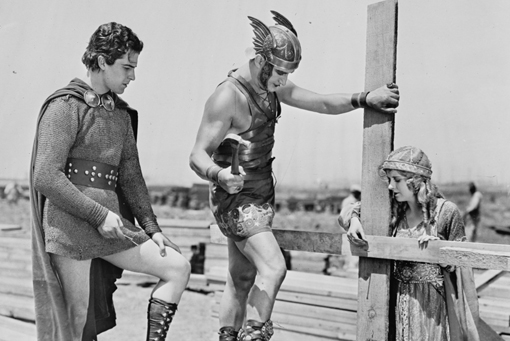Gods and Idols
Why are stars often called ‘gods’ or ‘goddesses’? How was antiquity used to boost the image of the developing film industry and its stars? What does this historical association tell us about cinema’s representation of past and present? Michael Williams explores the last century of moviemaking to answer some of these questions.
 About the author: Michael Williams is a Senior Lecturer in Film at Southampton University. His latest book is Film Stardom, Myth and Classicism: The Rise of Hollywood’s Gods, published in 2013 by Palgrave Macmillan. Some of his other publications include: British Silent Cinema and the Great War (Palgrave Macmillan, 2011); Ivor Novello: screen idol (British Film Institute, 2003); The idol body: stars, statuary and the classical epic. Film & History, 39, (2), 39-48. (doi:10.1353/flm.0.0120).
About the author: Michael Williams is a Senior Lecturer in Film at Southampton University. His latest book is Film Stardom, Myth and Classicism: The Rise of Hollywood’s Gods, published in 2013 by Palgrave Macmillan. Some of his other publications include: British Silent Cinema and the Great War (Palgrave Macmillan, 2011); Ivor Novello: screen idol (British Film Institute, 2003); The idol body: stars, statuary and the classical epic. Film & History, 39, (2), 39-48. (doi:10.1353/flm.0.0120).
www.southampton.ac.uk/film/michael_williams
Gods and Idols: Finding Ancient Inspiration for the Study of Film Stardom
Since the early 1900s film stars have been promoted as pseudo-mythic figures possessing ‘classical’ beauty. This reached its height in the mid-1920s, not only in the often neo-classical ‘picture palaces’ of cinema architecture, but also in richly evocative film fan-magazines. Here, the language and iconography of stardom implicitly and explicitly references a visual culture that frequently extends back to ancient Greece and Rome for inspiration, establishing a star discourse that persists today. Yet aside from the ground-breaking work of film scholars such as Richard Dyer (Stars, and Heavenly Bodies) and Edgar Morin (The Stars), as well as Leo Braudy’s tracing of the history of fame back to the era of Alexander (The Frenzy of Renown: Fame and Its History), this seemingly taken-for-granted discourse has been curiously neglected in academic study.
Olympus Moves to Hollywood
Reading a 1924 issue of Picture Show magazine back in the late 1990s, I was struck by the phrase ‘Do you admire Ivor Novello (England’s Apollo)’, as part of a promotional feature for the British stage and screen star. The casual association between a film star and a Greek god, its apparent obviousness highlighted in parenthesis, was intriguing as well as eloquent in the way it opened up a certain framework of viewing for the reader. For Novello, this might typically evoke a sculpture of a luminously handsome profile with a musical air, befitting the god of light and music, yet at the same time the reference is knowing and playful, like Novello’s persona, the same parenthesis giving an ironic wink to the audience in admission of its absurdity. I became keen to pursue the notion of ‘star divinization’ in greater depth.
… there’s something particularly evocative about the ruins of antiquity, the remnants of its now-lost gods and architecture
Sometimes fans were explicitly invited to make comparisons between stars and their iconographic forebears, as in images of Joan Crawford and Gloria Swanson posed next to statuettes of the Venus de Milo in images widely circulated in fan-magazines and trading cards. The favoured sculptural counterpart for men was the Belvedere Apollo, and so we find Richard Arlen gamely posing as the statue, which we also see reproduced, in a marvellous 1928 feature in America’s Photoplay magazine entitled ‘Olympus Moves to Hollywood’. While often tongue-in-cheek and seemingly glib, the deceptive simplicity of such images belies a complex dynamic that should not be too readily dismissed. When Swanson is framed next to the Venus, each icon reflects upon the other, and is layered beneath innumerable receptions of the past. This gives a sense of history, tactile sculptural shape, and pseudo-religious significance to the star as an otherwise flickering and ephemeral phenomenon.

Ramon Novarro, Francis Bushman and May McAvoy on the set of their 1925 biblical epic, BEN HUR (Image: Library of Congress / CC attribution).
 Learning on Screen
Learning on Screen